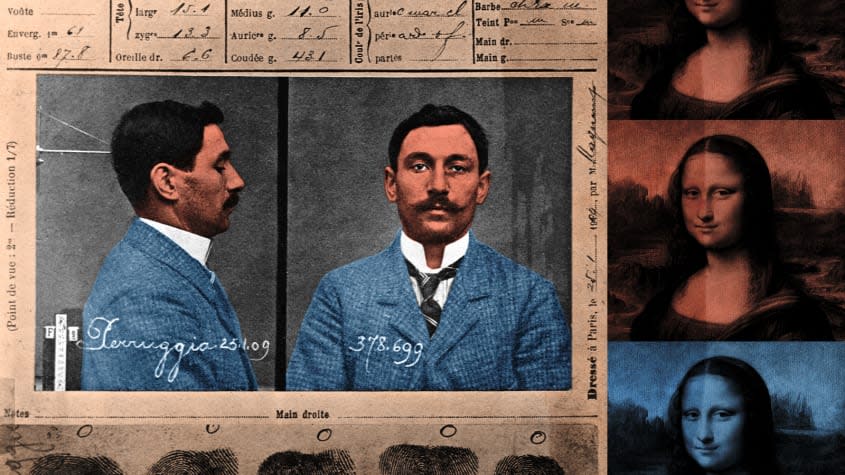A timeline of attacks on the Mona Lisa

Don't let that smile fool you — the Mona Lisa has seen some things. After a visitor attempted to smash its protective glass last week, the painting and its wild history of attempted vandalism and theft is back in the spotlight. Here's everything you need to know:
What happened to the Mona Lisa last week?
A masterpiece of the Renaissance, Leonardo da Vinci's Mona Lisa is known the world over, and every year, millions visit the Louvre in Paris to see this work of art up close. Last Sunday, a 36-year-old man disguised as an elderly woman in a wheelchair got too close — he stood up and smeared a piece of cake on the bulletproof glass protecting the painting. As he was led away by security guards, the man said in French, "Think about the Earth. There are people who are destroying the Earth. ... All artists tell you, think about the Earth — this is why I did this. Think about the planet." In a statement, the Louvre said the painting wasn't damaged by the pastry.
Has the Mona Lisa faced prior attacks?
This was just one of the Mona Lisa's many brushes with danger. The first came in 1911, when an Italian handyman and former Louvre worker named Vincenzo Peruggia — who helped construct the Mona Lisa's protective frame — swiped the painting. This theft is what made the Mona Lisa famous on a global scale — before that, it was considered one of Leonardo's minor works, ARTnews reports, but the disappearance made headlines and got the world interested in its whereabouts.
Peruggia held onto the Mona Lisa for about two years, hiding it in a trunk in his apartment, before he tried to sell it to an art dealer in Florence. The dealer notified the director of the Uffizi Galleries, who in turn tipped off the police. Peruggia maintained that the painting never should have left Italy and he was right to bring it back, but the legal system disagreed; he spent six months in prison, and the Mona Lisa said arrivederci to the motherland.
The Mona Lisa led a peaceful existence for the next several decades, until being subjected to multiple attacks in 1956. Someone first tried — and failed — to use a razor blade to damage the painting, ARTnews says, and another person threw acid on it during an exhibition in Montauban, France (it was at this point the decision was made to put glass in front of the painting or risk it being ruined beyond repair). Later that year, a Bolivian man named Hugo Unjaga Villegas chucked a rock at the work of art. "I had a stone in my pocket and suddenly the idea to throw it came to mind," he matter-of-factly explained at the time. The Mona Lisa was only slightly damaged; the rock chipped off a tiny speck of paint, but restorers were able to quickly make the repair.
In a rare international trip, the Mona Lisa left the Louvre in 1974 and headed to the National Museum in Tokyo. A Japanese woman named Tomoko Yonezu objected to the museum's treatment of people with disabilities, and on the first day the Mona Lisa was on display to the public, Yonezu tried to spray red paint on the masterpiece. No damage was done, but Yonezu was arrested and charged with a misdemeanor; she was found guilty and had to pay a 3,000 yen fine. Her stunt actually did make a difference — the National Museum scheduled a day when just people with disabilities could view the Mona Lisa.
More than 30 years later, the Mona Lisa's protective glass once again shielded her from an attack, this time involving a teacup. In August 2009, a Russian woman reached into her purse, grabbed the cup, and hurled it at the Mona Lisa. The painting was undisturbed, and the only victim was the innocent piece of porcelain. The Louvre said the woman was upset over being denied French citizenship, and a police spokesman told The New York Times she was taken to undergo a psychiatric exam.
Does the painting need better protection?
After this attack, the Louvre decided it was time to boost the Mona Lisa's security once again. Since 2019, the painting has been behind a more transparent piece of bulletproof glass. Not only does this upgraded glass offer better protection of the Mona Lisa, but it "really gives the impression of being very close to the painting," Vincent Delieuvin, curator of 16th-century Italian art at the Louvre, told Reuters.
What is it about the Mona Lisa that gets people to become thieves, vandals, and destroyers of perfectly good teacups? It's clear that when people attack the Mona Lisa, they bring attention to themselves and their causes, but there are other icons and symbols in the world that don't receive as much abuse. "I'm not sure that I feel like there's anything about the painting itself that elicits this reaction," Cammy Brothers, associate professor of art history at Northeastern University, told NPR. "I think it's very much the kind of mystique that is created culturally around it."
You may also like
7 cartoons about America's gun crisis
5 cartoons about the Uvalde police response
Queen Elizabeth has tea with Paddington Bear in video shown at Jubilee concert

